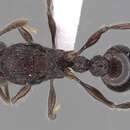Taxonomic History
provided by Antweb
Tetramorium capillosum Bolton, 1980 PDF: 236, fig. 13 (w.) GABON. Afrotropic.
AntCat AntWiki HOL
- bibliographic citation
- AntWeb. Version 8.45.1. California Academy of Science, online at https://www.antweb.org. Accessed 15 December 2022.
Description
provided by Zookeys
Head longer than wide (CI 94 - 96); posterior head margin moderately concave. Anterior clypeal margin entire and convex. Frontal carinae strongly developed, approaching or ending at posterior head margin. Antennal scrobes narrow but very well-developed with clearly defined margins all around. Antennal scapes moderately long, not reaching posterior head margin (SI 80 - 83). Eyes of moderate size (OI 23 - 25). Mesosomal outline in profile weakly convex, moderately marginate from lateral to dorsal mesosoma; promesonotal suture and metanotal groove absent; mesosoma comparatively stout and high (LMI 39 - 43). Propodeal spines relatively long to very long, spinose, and acute (PSLI 31 - 43); propodeal lobes short, triangular to elongate-triangular, and usually acute. Petiolar node in profile rectangular nodiform, approximately as high as long to weakly higher than long (LPeI 89 - 100), anterior and posterior faces approximately parallel, posterodorsal margin situated higher than anterodorsal, anterodorsal and posterodorsal angles relatively rounded, petiolar dorsum convex; node in dorsal view approximately 1.1 times longer than wide (DPeI 86 - 94). Postpetiole in profile relatively high and moderately anteroposteriorly compressed, approximately 1.2 to 1.3 times higher than long (LPpI 70 - 78); in dorsal view around 1.3 to 1.4 times wider than long (DPpI 130 - 139). Postpetiole in profile thinner and higher than petiolar node, in dorsal view approximately 1.3 to 1.4 times wider than petiolar node (PPI 127 - 138). Mandibles strongly longitudinally rugose; clypeus longitudinally rugulose, usually with three to five rugulae, median rugula better developed; cephalic dorsum between frontal carinae irregularly longitudinally rugose to reticulate rugose, posteriorly towards posterior head margin fully reticulate-rugose, anteriorly towards posterior clypeal margin more regularly longitudinally rugose; scrobal area unsculptured, smooth, and shining; lateral and ventral head longitudinally rugose to reticulate-rugose. Mesosoma laterally and dorsally strongly irregularly longitudinally rugose. Forecoxae unsculptured, smooth, and shining. Both waist segments with strong sculpture, mainly longitudinally rugose. Gaster unsculptured, smooth, and shining. Ground sculpture generally faint to absent everywhere on body. Whole body with abundant, very long, and fine standing hairs; first gastral tergite without appressed pubescence. Anterior edges of antennal scapes with suberect to erect hairs. Body of uniform very dark brown to black colour.
- license
- cc-by-3.0
- copyright
- Francisco Hita Garcia, Brian L. Fisher
- bibliographic citation
- Garcia F, Fisher B (2013) The Tetramorium tortuosum species group (Hymenoptera, Formicidae, Myrmicinae) revisited - taxonomic revision of the Afrotropical T. capillosum species complex ZooKeys 299: 77–99
- author
- Francisco Hita Garcia
- author
- Brian L. Fisher
Distribution
provided by Zookeys
Currently, Tetramorium capillosum is found throughout Gabon, southern Cameroon, eastern Central African Republic, and then much further east in the northeastern Democratic Republic of Congo and northwestern Uganda (Figure 7). As noted above, the disjunctive range is almost certainly due to a sampling artefact, and it is very likely that Tetramorium capillosum is also encountered in Congo, and in much more of the Democratic Republic of Congo than just the northeastern locality of Epulu. Also, it seems unlikely that the species does not occur in Equatorial Guinea since it is found further north, south, and east, and was likely missed due to a sampling artefact. With the available material in mind, it seems that Tetramorium capillosum lives in leaf litter and/or on the ground, and is found at elevations from 40 to 1081 m.
- license
- cc-by-3.0
- copyright
- Francisco Hita Garcia, Brian L. Fisher
- bibliographic citation
- Garcia F, Fisher B (2013) The Tetramorium tortuosum species group (Hymenoptera, Formicidae, Myrmicinae) revisited - taxonomic revision of the Afrotropical T. capillosum species complex ZooKeys 299: 77–99
- author
- Francisco Hita Garcia
- author
- Brian L. Fisher

